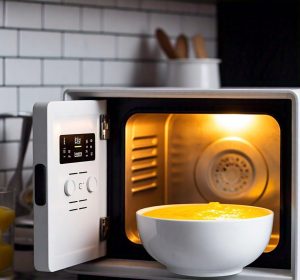Craving a bright, zesty flavor without the long baking time? These 4 lemon microwave recipes are your answer.
They deliver that signature citrus punch we all love, and you don’t even need to turn on your oven.
We’re covering everything from a quick mug cake to a smooth lemon curd.
Jump To:
Lemon Blueberry Microwave Mug Cake
This lemon blueberry mug cake has become our go-to when we need something sweet in under 5 minutes. The combination of tart lemon zest with juicy blueberries creates that perfect balance we crave.
From our experience, fresh blueberries work better than frozen since frozen ones tend to release too much moisture and make the cake soggy. We learned this the hard way after a few watery disasters!
What makes this recipe special is how the microwave actually intensifies the lemon flavor. The quick cooking time traps all those essential oils from the zest, giving you a more concentrated citrus punch than traditional oven baking.
One mistake we made early on was overmixing the batter. This creates a tough, rubbery texture that nobody wants. Just fold the ingredients until barely combined – a few lumps are perfectly fine.
The cooking time varies between 60-90 seconds depending on your microwave’s wattage. We strongly suggest checking at 60 seconds and adding time in 15-second intervals. The cake should spring back lightly when touched and pull away slightly from the mug edges.
Lemon Poppy Seed Microwave Mug Muffin
Our lemon poppy seed muffin recipe brings that classic bakery flavor right to your kitchen counter. The poppy seeds add a delightful crunch that contrasts beautifully with the tender, lemony crumb.
What I found works best is soaking the poppy seeds in lemon juice for about 2 minutes before mixing. This softens them slightly and helps distribute the lemon flavor more evenly throughout the muffin.
Temperature matters more than you’d think with this recipe. Room temperature ingredients blend much smoother than cold ones straight from the fridge. We’ve noticed cold milk can cause the batter to seize up and create an uneven texture.
From my own experience, this muffin benefits from a simple glaze drizzled on top while it’s still warm. A mix of powdered sugar and fresh lemon juice creates that authentic bakery-style finish we all love.
The poppy seeds can sometimes stick to the bottom of the mug during cooking. To prevent this, we lightly grease the mug with butter instead of cooking spray – it creates a better barrier and adds extra richness.
Copycat Starbucks Lemon Loaf Microwave Quick-bake
This copycat Starbucks lemon loaf recipe gets surprisingly close to the real thing, and we’ve perfected it after countless trials. The secret lies in achieving that dense, pound cake-like texture that makes the original so addictive.
Greek yogurt is the game-changer ingredient here. It provides the moisture and tang that mimics Starbucks’ version while keeping the texture appropriately dense. Regular yogurt tends to make it too light and fluffy.
One thing we discovered is that this recipe needs a longer cooking time than typical mug cakes – usually 90-120 seconds. The thicker batter requires more time to cook through properly without becoming rubbery.
From our testing, the glaze makes or breaks this recipe. We use a 3:1 ratio of powdered sugar to fresh lemon juice, whisked until completely smooth. Apply it while the loaf is still warm so it soaks in slightly but maintains that signature white coating.
What I found works best is letting the “loaf” cool for 2-3 minutes before adding the glaze. This prevents it from completely melting off while still allowing some absorption for maximum flavor impact.
Also See: Chamomile Tea Cake – A Spring Microwave Treat
Quick and Easy Microwave Lemon Curd
This microwave lemon curd recipe has revolutionized how we make this classic spread. What traditionally takes 20-30 minutes of constant stirring on the stovetop now takes just 3-4 minutes in the microwave.
The key is whisking every 30 seconds to prevent the eggs from scrambling. I learned this lesson after my first attempt resulted in chunky, curdled disaster that went straight into the trash.
From our experience, using room temperature eggs prevents temperature shock when you add the hot lemon mixture. Cold eggs straight from the fridge can seize up and create an uneven texture that’s impossible to fix.
What I found works best is straining the finished curd through a fine-mesh sieve. This removes any bits of cooked egg or lemon zest that might have clumped together during the rapid cooking process.
One mistake we made early on was overcooking it. The curd continues to thicken as it cools, so stop when it coats the back of a spoon. Overcooked curd becomes grainy and loses that silky smoothness we’re after.
We strongly suggest covering the surface with plastic wrap while it cools to prevent a skin from forming. This simple step keeps your curd perfectly smooth and ready for spreading on scones, toast, or eating straight from the spoon.
Maximizing Lemon Flavor in Microwave Cooking
Getting maximum lemon flavor from microwave cooking requires different techniques than traditional baking. The rapid cooking time can actually work in our favor if we know how to harness it properly.
Fresh lemon zest beats bottled lemon extract every time. The microwave traps those volatile oils that give real punch to your recipes. We use a microplane grater to get the finest zest possible – larger pieces can become bitter when heated quickly.
From my own experience, adding lemon juice at different stages creates layers of flavor. Some goes in the batter for overall tartness, and a splash after cooking brightens the entire dish. This technique prevents that flat, one-dimensional lemon taste.
Room temperature lemons yield 40% more juice than cold ones. Roll them firmly on the counter before cutting to break down the internal membranes. This simple trick has saved us from squeezing rock-hard lemons countless times.
What I found works best is combining both zest and juice in most recipes. The zest provides aromatic oils while the juice gives that mouth-puckering acidity we crave. Using only one or the other leaves the flavor incomplete.
One mistake we made was adding too much zest early on. More isn’t always better – it can turn bitter and overpower other flavors. Start with the zest of half a lemon and adjust from there based on your taste preferences.
Essential Tips for Microwaving Citrus Safely
Microwaving citrus requires specific safety precautions that many people overlook. Whole citrus fruits can explode due to steam buildup, creating a dangerous mess and potentially damaging your microwave.
Always pierce the skin of whole lemons before microwaving, even if you’re just warming them to extract more juice. We use a fork to make 6-8 small holes around the fruit. This allows steam to escape safely during heating.
From our experience, glass containers work best for citrus-based recipes. The acid in lemons can react with certain plastics, creating off-flavors and potentially releasing harmful compounds. We stick to microwave-safe glass or ceramic mugs exclusively.
Watch for superheating when warming lemon juice alone. The liquid can become dangerously hot without bubbling, then explode when disturbed. Add a wooden stick or leave a spoon in the container to provide nucleation sites for bubbles.
What I found works best is using 50% power for longer cooking times rather than full power for shorter periods. This gentler approach prevents hot spots that can cause citrus oils to become bitter or acidic mixtures to curdle.
One safety tip we learned the hard way – let citrus-based dishes cool for at least 30 seconds before handling. The natural sugars and acids retain heat longer than you’d expect, and we’ve had a few burned tongues to prove it.
Always use oven mitts when removing containers, even if they don’t look hot. Citrus recipes often create steam that makes handles and rims extremely hot while the container itself appears cool.
Ready to Brighten Your Kitchen? Try These Lemon Recipes Today!
We’ve shared four amazing lemon microwave recipes that prove you don’t need a full oven to create something spectacular. Each recipe takes under 10 minutes and delivers that perfect balance of tangy citrus brightness and comforting sweetness. From the fluffy mug cake to the silky lemon curd, these treats are waiting to become your new go-to desserts.
Start with whichever recipe calls to you most – maybe the copycat Starbucks lemon loaf if you’re craving something familiar, or dive into the quick lemon curd if you want to impress guests. Your microwave is about to become your favorite baking tool, and your taste buds will thank you for these zesty, satisfying creations.







